2020 HYUNDAI GENESIS G90 brake
[x] Cancel search: brakePage 306 of 538
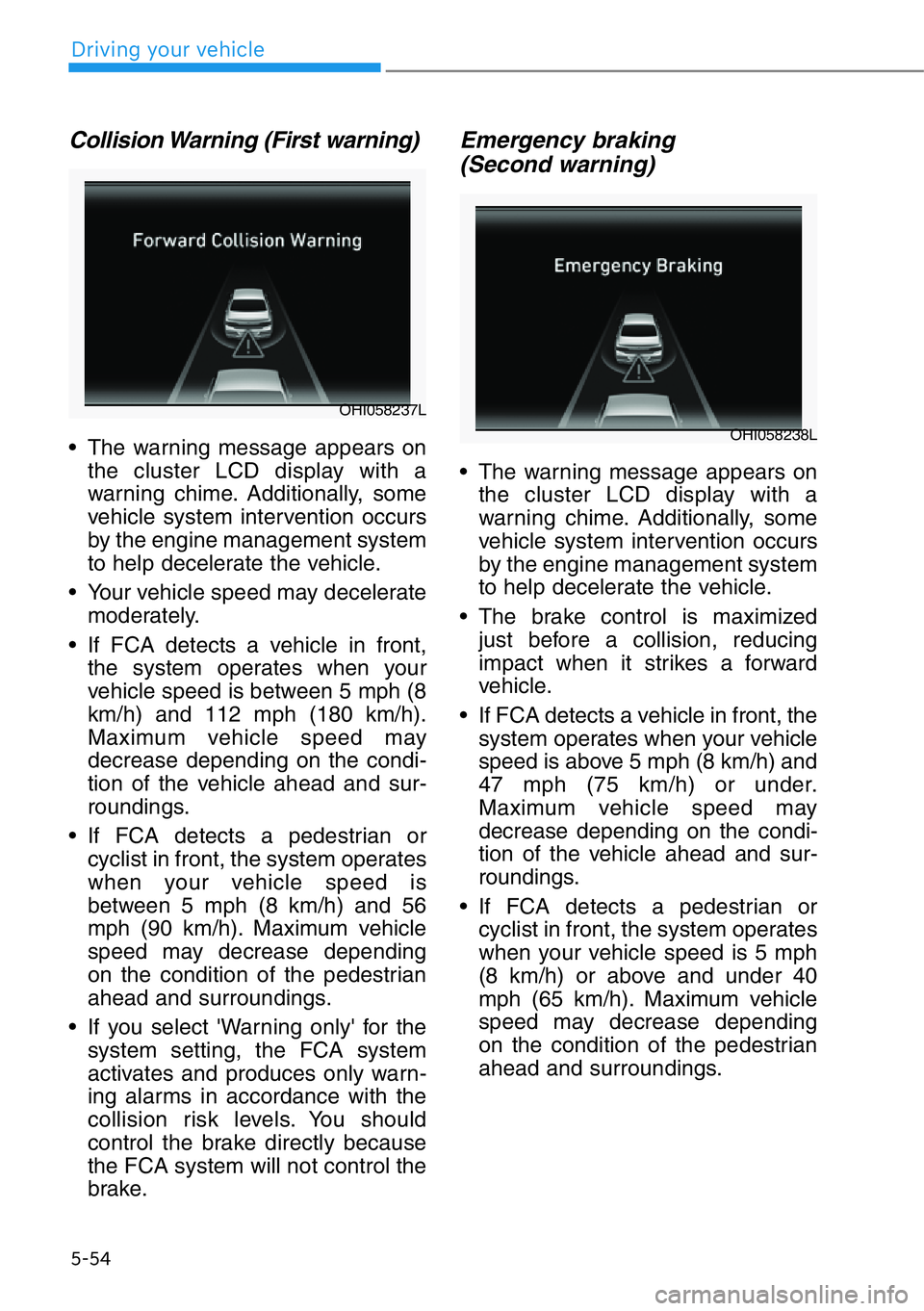
Collision Warning (First warning)
• The warning message appears on
the cluster LCD display with a
warning chime. Additionally, some
vehicle system intervention occurs
by the engine management system
to help decelerate the vehicle.
• Your vehicle speed may decelerate
moderately.
• If FCA detects a vehicle in front,
the system operates when your
vehicle speed is between 5 mph (8
km/h) and 112 mph (180 km/h).
Maximum vehicle speed may
decrease depending on the condi-
tion of the vehicle ahead and sur-
roundings.
• If FCA detects a pedestrian or
cyclist in front, the system operates
when your vehicle speed is
between 5 mph (8 km/h) and 56
mph (90 km/h). Maximum vehicle
speed may decrease depending
on the condition of the pedestrian
ahead and surroundings.
• If you select 'Warning only' for the
system setting, the FCA system
activates and produces only warn-
ing alarms in accordance with the
collision risk levels. You should
control the brake directly because
the FCA system will not control the
brake.
Emergency braking
(Second warning)
• The warning message appears on
the cluster LCD display with a
warning chime. Additionally, some
vehicle system intervention occurs
by the engine management system
to help decelerate the vehicle.
• The brake control is maximized
just before a collision, reducing
impact when it strikes a forward
vehicle.
• If FCA detects a vehicle in front, the
system operates when your vehicle
speed is above 5 mph (8 km/h) and
47 mph (75 km/h) or under.
Maximum vehicle speed may
decrease depending on the condi-
tion of the vehicle ahead and sur-
roundings.
• If FCA detects a pedestrian or
cyclist in front, the system operates
when your vehicle speed is 5 mph
(8 km/h) or above and under 40
mph (65 km/h). Maximum vehicle
speed may decrease depending
on the condition of the pedestrian
ahead and surroundings.
5-54
Driving your vehicle
OHI058238L
OHI058237L
Page 307 of 538
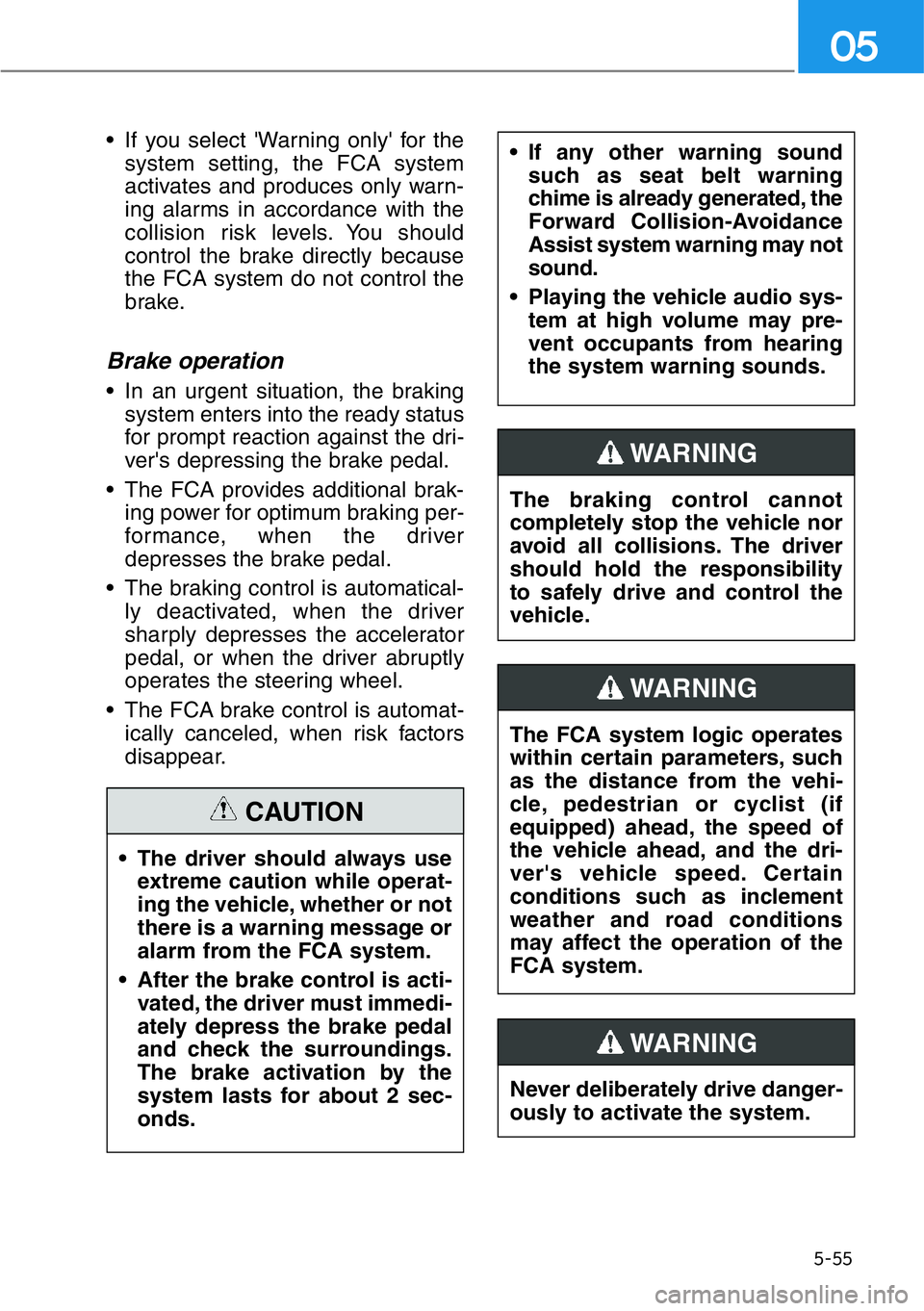
• If you select 'Warning only' for the
system setting, the FCA system
activates and produces only warn-
ing alarms in accordance with the
collision risk levels. You should
control the brake directly because
the FCA system do not control the
brake.
Brake operation
• In an urgent situation, the braking
system enters into the ready status
for prompt reaction against the dri-
ver's depressing the brake pedal.
• The FCA provides additional brak-
ing power for optimum braking per-
formance, when the driver
depresses the brake pedal.
• The braking control is automatical-
ly deactivated, when the driver
sharply depresses the accelerator
pedal, or when the driver abruptly
operates the steering wheel.
• The FCA brake control is automat-
ically canceled, when risk factors
disappear.
5-55
05
• The driver should always use
extreme caution while operat-
ing the vehicle, whether or not
there is a warning message or
alarm from the FCA system.
• After the brake control is acti-
vated, the driver must immedi-
ately depress the brake pedal
and check the surroundings.
The brake activation by the
system lasts for about 2 sec-
onds.
CAUTION
• If any other warning sound
such as seat belt warning
chime is already generated, the
Forward Collision-Avoidance
Assist system warning may not
sound.
• Playing the vehicle audio sys-
tem at high volume may pre-
vent occupants from hearing
the system warning sounds.
The braking control cannot
completely stop the vehicle nor
avoid all collisions. The driver
should hold the responsibility
to safely drive and control the
vehicle.
WARNING
The FCA system logic operates
within certain parameters, such
as the distance from the vehi-
cle, pedestrian or cyclist (if
equipped) ahead, the speed of
the vehicle ahead, and the dri-
ver's vehicle speed. Certain
conditions such as inclement
weather and road conditions
may affect the operation of the
FCA system.
WARNING
Never deliberately drive danger-
ously to activate the system.
WARNING
Page 310 of 538
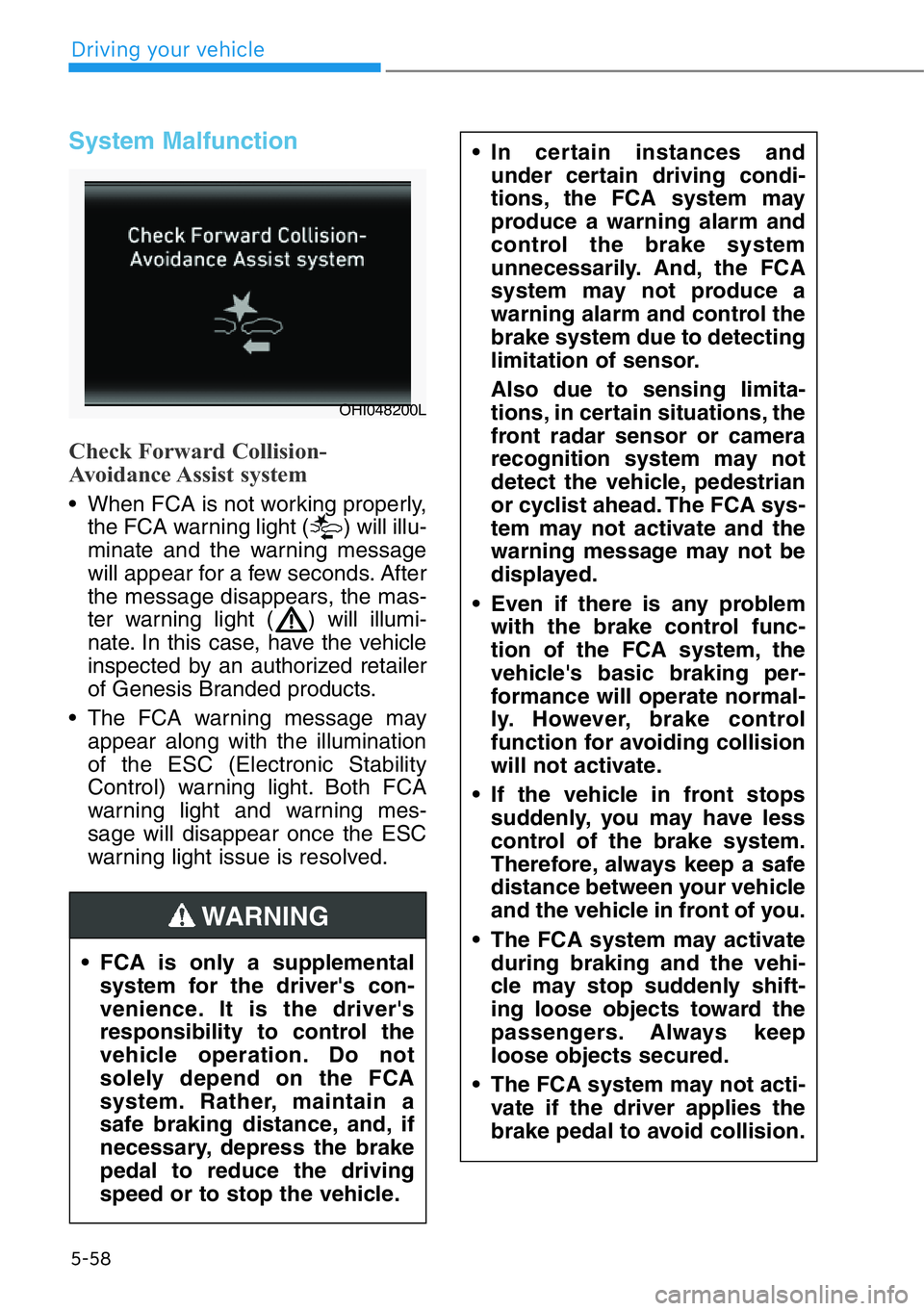
5-58
Driving your vehicle
System Malfunction
Check Forward Collision-
Avoidance Assist system
• When FCA is not working properly,
the FCA warning light ( ) will illu-
minate and the warning message
will appear for a few seconds. After
the message disappears, the mas-
ter warning light ( ) will illumi-
nate. In this case, have the vehicle
inspected by an authorized retailer
of Genesis Branded products.
• The FCA warning message may
appear along with the illumination
of the ESC (Electronic Stability
Control) warning light. Both FCA
warning light and warning mes-
sage will disappear once the ESC
warning light issue is resolved.
OHI048200L
• FCA is only a supplemental
system for the driver's con-
venience. It is the driver's
responsibility to control the
vehicle operation. Do not
solely depend on the FCA
system. Rather, maintain a
safe braking distance, and, if
necessary, depress the brake
pedal to reduce the driving
speed or to stop the vehicle.
WARNING
• In certain instances and
under certain driving condi-
tions, the FCA system may
produce a warning alarm and
control the brake system
unnecessarily. And, the FCA
system may not produce a
warning alarm and control the
brake system due to detecting
limitation of sensor.
Also due to sensing limita-
tions, in certain situations, the
front radar sensor or camera
recognition system may not
detect the vehicle, pedestrian
or cyclist ahead. The FCA sys-
tem may not activate and the
warning message may not be
displayed.
• Even if there is any problem
with the brake control func-
tion of the FCA system, the
vehicle's basic braking per-
formance will operate normal-
ly. However, brake control
function for avoiding collision
will not activate.
• If the vehicle in front stops
suddenly, you may have less
control of the brake system.
Therefore, always keep a safe
distance between your vehicle
and the vehicle in front of you.
• The FCA system may activate
during braking and the vehi-
cle may stop suddenly shift-
ing loose objects toward the
passengers. Always keep
loose objects secured.
• The FCA system may not acti-
vate if the driver applies the
brake pedal to avoid collision.
Page 311 of 538
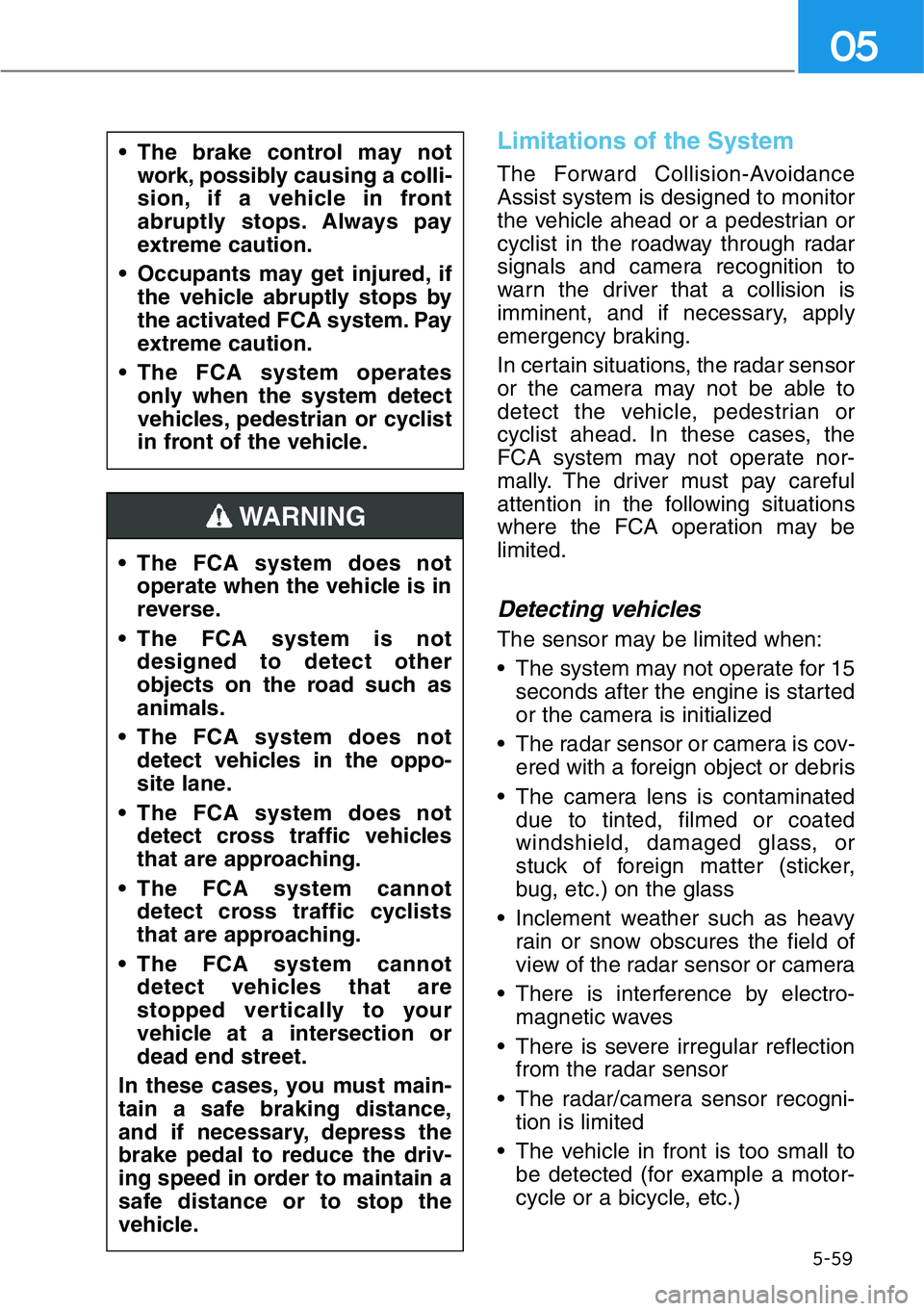
5-59
05
Limitations of the System
The Forward Collision-Avoidance
Assist system is designed to monitor
the vehicle ahead or a pedestrian or
cyclist in the roadway through radar
signals and camera recognition to
warn the driver that a collision is
imminent, and if necessary, apply
emergency braking.
In certain situations, the radar sensor
or the camera may not be able to
detect the vehicle, pedestrian or
cyclist ahead. In these cases, the
FCA system may not operate nor-
mally. The driver must pay careful
attention in the following situations
where the FCA operation may be
limited.
Detecting vehicles
The sensor may be limited when:
• The system may not operate for 15
seconds after the engine is started
or the camera is initialized
• The radar sensor or camera is cov-
ered with a foreign object or debris
• The camera lens is contaminated
due to tinted, filmed or coated
windshield, damaged glass, or
stuck of foreign matter (sticker,
bug, etc.) on the glass
• Inclement weather such as heavy
rain or snow obscures the field of
view of the radar sensor or camera
• There is interference by electro-
magnetic waves
• There is severe irregular reflection
from the radar sensor
• The radar/camera sensor recogni-
tion is limited
• The vehicle in front is too small to
be detected (for example a motor-
cycle or a bicycle, etc.) • The FCA system does not
operate when the vehicle is in
reverse.
• The FCA system is not
designed to detect other
objects on the road such as
animals.
• The FCA system does not
detect vehicles in the oppo-
site lane.
• The FCA system does not
detect cross traffic vehicles
that are approaching.
• The FCA system cannot
detect cross traffic cyclists
that are approaching.
• The FCA system cannot
detect vehicles that are
stopped vertically to your
vehicle at a intersection or
dead end street.
In these cases, you must main-
tain a safe braking distance,
and if necessary, depress the
brake pedal to reduce the driv-
ing speed in order to maintain a
safe distance or to stop the
vehicle.
WARNING
• The brake control may not
work, possibly causing a colli-
sion, if a vehicle in front
abruptly stops. Always pay
extreme caution.
• Occupants may get injured, if
the vehicle abruptly stops by
the activated FCA system. Pay
extreme caution.
• The FCA system operates
only when the system detect
vehicles, pedestrian or cyclist
in front of the vehicle.
Page 313 of 538

5-61
05
• Driving on a curve
The performance of Forward
Collision-Avoidance Assist system
may be limited when driving on a
curved road.
The front view camera or front
radar sensor recognition system
may not detect the vehicle, pedes-
trian or cyclist traveling in front on
a curved road.
This may result in no alarm and
braking when necessary. Always
pay attention to road and driving
conditions, and if necessary,
depress the brake pedal to reduce
your driving speed in order to
maintain a safe distance.Forward Collision-Avoidance Assist
system may recognize a vehicle or
pedestrian or cyclist in the next lane
or outside the lane when driving on a
curved road.
If this occurs, the system may unnec-
essarily alarm the driver and apply
the brake.
Always pay attention to road and
driving conditions, while driving.
OHI058305LOHI058306L
Page 314 of 538

5-62
Driving your vehicle
• Driving on a slope
The performance of Forward
Collision-Avoidance Assist system
may be decreased while driving
upward or downward on a slope.
The front view camera or front
radar sensor recognition may not
detect the vehicle, pedestrian or
cyclist in front.
This may result in unnecessary
alarm and braking or no alarm and
braking when necessary.
When the system suddenly recog-
nizes the vehicle, pedestrian or
cyclist in front while passing over a
slope, you may experience sharp
deceleration. Always keep your
eyes forward while driving upward
or downward on a slope, and, if
necessary, depress the brake
pedal to reduce your driving speed
in order to maintain distance.• Changing lanes
When a vehicle changes lanes in
front of you, the FCA system may
not immediately detect the vehicle,
especially if the vehicle changes
lanes abruptly. In this case, you
must maintain a safe braking dis-
tance, and if necessary, depress
the brake pedal to reduce your
driving speed in order to maintain a
safe distance.
When driving in stop-and-go traffic,
and a vehicle in front of you
merges out of the lane, the FCA
system may not immediately
detect the new vehicle that is now
in front of you. In this case, you
must maintain a safe braking dis-
tance, and if necessary, depress
the brake pedal to reduce your
driving speed in order to maintain a
safe distance.
OHI058294OHI058307L
OHI058308L
Page 315 of 538
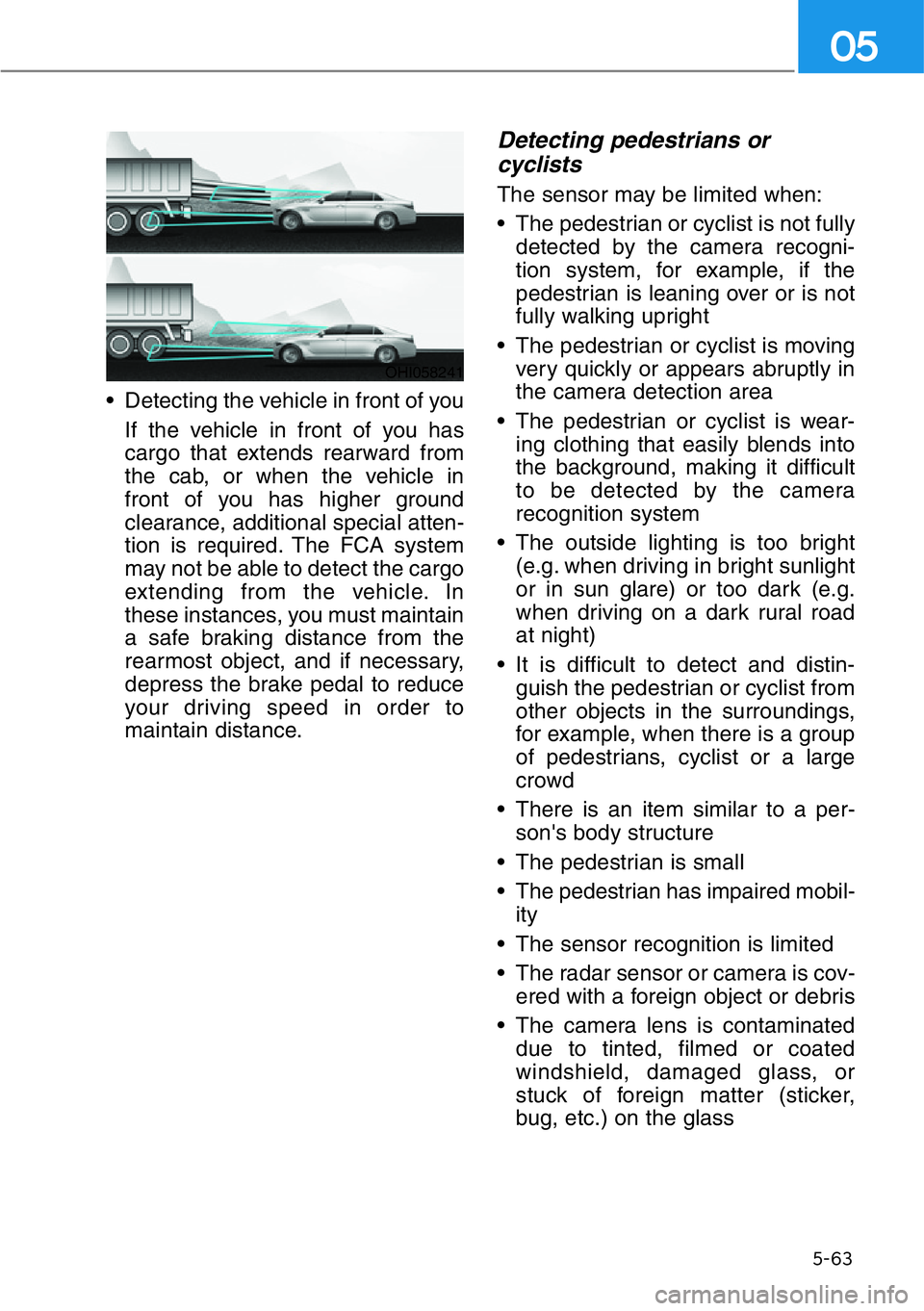
5-63
05
• Detecting the vehicle in front of you
If the vehicle in front of you has
cargo that extends rearward from
the cab, or when the vehicle in
front of you has higher ground
clearance, additional special atten-
tion is required. The FCA system
may not be able to detect the cargo
extending from the vehicle. In
these instances, you must maintain
a safe braking distance from the
rearmost object, and if necessary,
depress the brake pedal to reduce
your driving speed in order to
maintain distance.
Detecting pedestrians or
cyclists
The sensor may be limited when:
• The pedestrian or cyclist is not fully
detected by the camera recogni-
tion system, for example, if the
pedestrian is leaning over or is not
fully walking upright
• The pedestrian or cyclist is moving
very quickly or appears abruptly in
the camera detection area
• The pedestrian or cyclist is wear-
ing clothing that easily blends into
the background, making it difficult
to be detected by the camera
recognition system
• The outside lighting is too bright
(e.g. when driving in bright sunlight
or in sun glare) or too dark (e.g.
when driving on a dark rural road
at night)
• It is difficult to detect and distin-
guish the pedestrian or cyclist from
other objects in the surroundings,
for example, when there is a group
of pedestrians, cyclist or a large
crowd
• There is an item similar to a per-
son's body structure
• The pedestrian is small
• The pedestrian has impaired mobil-
ity
• The sensor recognition is limited
• The radar sensor or camera is cov-
ered with a foreign object or debris
• The camera lens is contaminated
due to tinted, filmed or coated
windshield, damaged glass, or
stuck of foreign matter (sticker,
bug, etc.) on the glass
OHI058241
Page 326 of 538
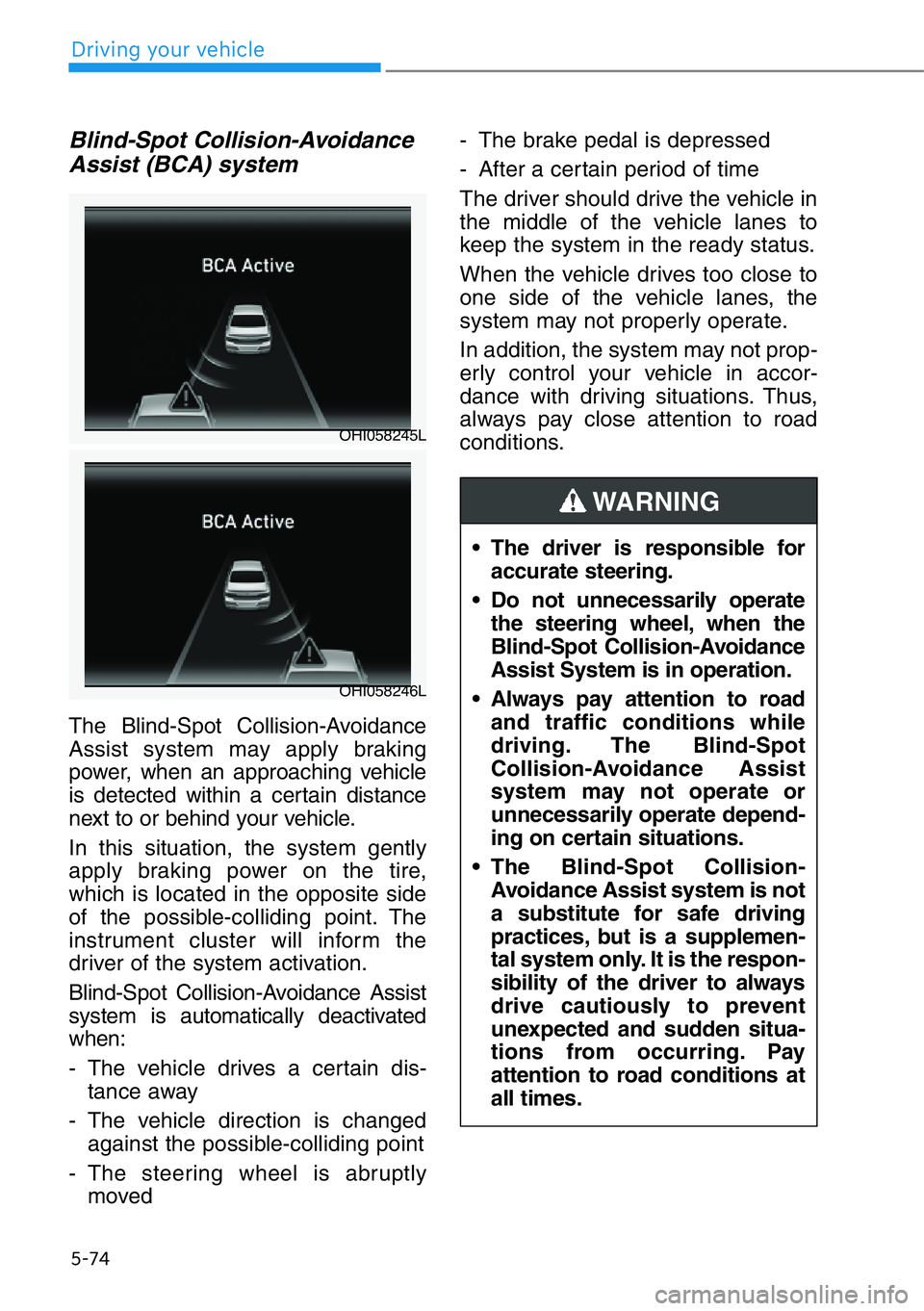
5-74
Driving your vehicle
Blind-Spot Collision-Avoidance
Assist (BCA) system
The Blind-Spot Collision-Avoidance
Assist system may apply braking
power, when an approaching vehicle
is detected within a certain distance
next to or behind your vehicle.
In this situation, the system gently
apply braking power on the tire,
which is located in the opposite side
of the possible-colliding point. The
instrument cluster will inform the
driver of the system activation.
Blind-Spot Collision-Avoidance Assist
system is automatically deactivated
when:
- The vehicle drives a certain dis-
tance away
- The vehicle direction is changed
against the possible-colliding point
- The steering wheel is abruptly
moved- The brake pedal is depressed
- After a certain period of time
The driver should drive the vehicle in
the middle of the vehicle lanes to
keep the system in the ready status.
When the vehicle drives too close to
one side of the vehicle lanes, the
system may not properly operate.
In addition, the system may not prop-
erly control your vehicle in accor-
dance with driving situations. Thus,
always pay close attention to road
conditions.
OHI058245L
OHI058246L
• The driver is responsible for
accurate steering.
• Do not unnecessarily operate
the steering wheel, when the
Blind-Spot Collision-Avoidance
Assist System is in operation.
• Always pay attention to road
and traffic conditions while
driving. The Blind-Spot
Collision-Avoidance Assist
system may not operate or
unnecessarily operate depend-
ing on certain situations.
• The Blind-Spot Collision-
Avoidance Assist system is not
a substitute for safe driving
practices, but is a supplemen-
tal system only. It is the respon-
sibility of the driver to always
drive cautiously to prevent
unexpected and sudden situa-
tions from occurring. Pay
attention to road conditions at
all times.
WARNING